![]()
![]()
![]()
Use LEFT and RIGHT arrow keys to navigate between flashcards;
Use UP and DOWN arrow keys to flip the card;
H to show hint;
A reads text to speech;
60 Cards in this Set
- Front
- Back
|
When a sensory receptor is stimulated, producing nerve impulses which travel to the brain. |
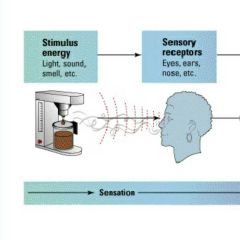
Sensation |
|
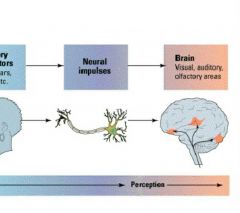
Perception |
When brain processes info from neural impulses, with the help of emotions, experience etc to create interpretation and ____ of info |
|

Bottom-up processing |
Processing sensory information as it is coming in eg seeing shapes on paper |
|

Top-down processing |
Builds on bottom-up processing and constructs perceptions based on experience and expectations eg noticing those lines create the shadow of a face |
|
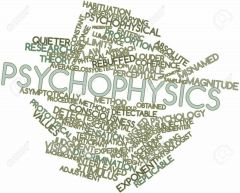
Psychophysics |
The study of the relationship between physical stimuli and the sensations and perceptions they produce |
|
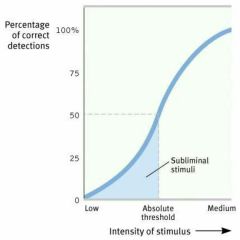
Absolute threshold |
Minimum stimulation necessary to detect it 50% of the time. |
|
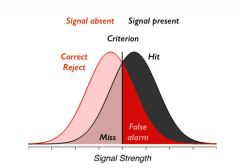
Signal detection theory |
Predicts when we will detect weak signals of stimuli (measured as a ratio of "hits" to "false alarms" |
|
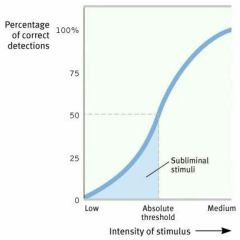
Subliminal |
(Of a stimulus) means below absolute threshold- can affect person without them being aware of it |
|

Priming |
When exposure to one stimulus can influence the response to a later stimulus. |
|

Difference threshold |
Also called JND. Minimum difference that can be detected between two stimuli 50% of the time. Proportional |
|
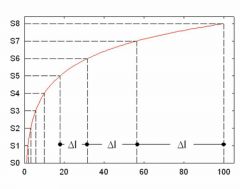
Webster's Law |
For difference to be noticeable, 2 stimuli must differ by at least a certain constant proportion. |
|
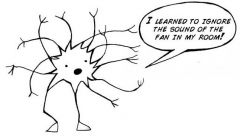
Sensory adaption |
When sensitivity diminishes to an unchanging stimulus. |
|
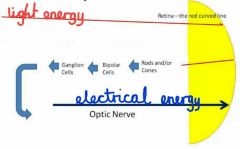
Transduction |
Process of converting energy into another form
e.g: in eyes; light energy transduced to electrical energy (neural impulses) |
|

Wavelength |
Length of wave from one peak to the next |
|
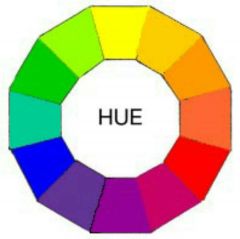
Hue |
Brightest and purest form of a colour independent of intensity and lightness.
Dependant on its dominant wavelength. |
|
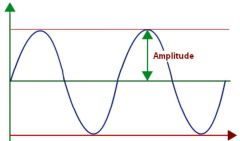
Intensity |
Amount of energy in a wave. Determined by amplitude |
|

Pupil |
Dark circular opening in Centre of iris. Varies in size to regulate amount of light reaching retina. |
|

Iris |
Flat, colored, ring-shaped membrane behind the cornea of the eye, with an adjustable circular opening (pupil) in the center. |
|
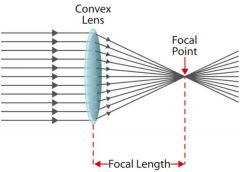
Lens |
Focuses light rays into image on the retina |
|
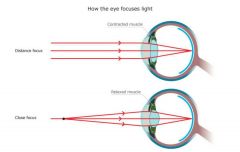
Accommodation |
Changing curvature of the lens to accommodate for objects closer or further away |
|
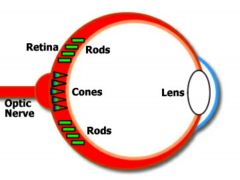
Rods |
Photo receptor in eye. 120 million.
Usually shares bipolar cells hence low detail sensitivity. Located in periphery too. Doesn't need bright light for colour hence good for seeing in dim light. |
|
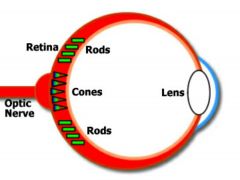
Cones |
Photoreceptor in eye. 6 million and concentrated in fovea- area of focused bright light. Hence good colour sensitivity and detail sensitivity |
|
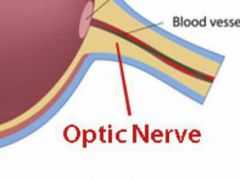
Optic nerve |
Convergence of axons of ganglion cells. Sends info to Thalamus en route to visual cortex. |
|
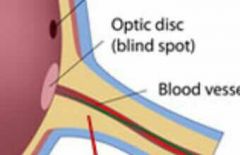
Blind spot |
Where optic nerve leaves eye- no receptors in this area |
|
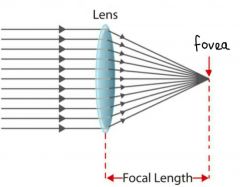
Fovea |
Retina's area of central focus of light rays. Centre of retina. |
|
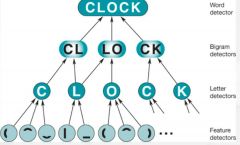
Feature detectors |
Cells in visual cortex that respond to lines, angles, edges and movements. |
|

Parallel processing |
Processing colour, form, motion and depth of a visual scene simultaneously |
|
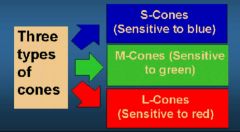
Young-Helmholtz trichromatic (three colour) theory |
Thought that cones in eye must work in teams of three. Inferred from three light waves which create any colour- red, green and blue |
|
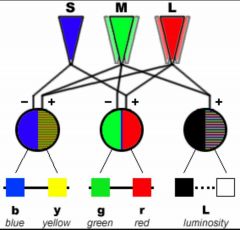
Opponent- process theory |
That as visual info leaves receptor cells, it is analysed in terms of 3 sets of opponent colours: red-green, yellow-blue and white-black |
|
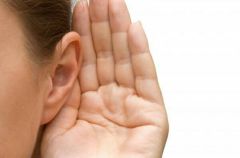
Audition |
Sensation of sound |
|
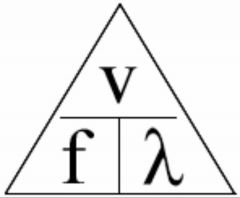
Frequency |
In Hertz, waves per minute |
|

Pitch |
Determined by frequency- how high or low a note or sound is |
|
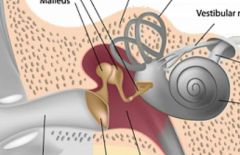
Middle ear |
the air-filled central cavity of the ear, behind the eardrum. |
|

Cochlea |
Vibrations from tiny bones cause fluid inside to move.
Bends hair cells which trigger impulses in nerves.
Sends neural impulses to Thalamus en route to temporal lobe's auditory cortex |
|
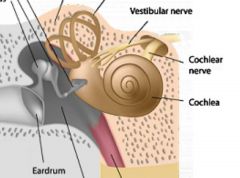
Inner ear |
The portion of the ear within the temporal bone that is involved in hearing and balance and includes the semicircular canals, vestibule, and cochlea. |
|

Place theory |
Suggests that we hear different pitches because different sound waves trigger activity at different places along cochlea's basilar membrane. High pitch near beginning, low pitch near end of membrane. |
|
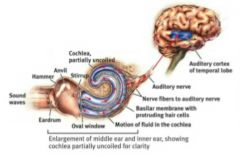
Frequency theory |
Suggests brain monitors frequency of neural impulses traveling up auditory nerve to determine pitch |
|
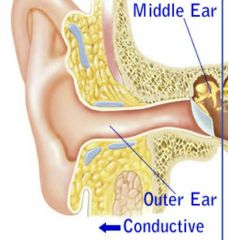
Conductive hearing loss |
When mechanical system that conducts sound waves is damaged. Eg earwax, punctured eardrum, problem with tiny bones etc |
|

Sensorineural hearing loss |
Deafness caused by damage to inner ear eg cochlea's hair cell receptors or associated nerves. More common. Due to loud noise, ageing, heredity. |
|
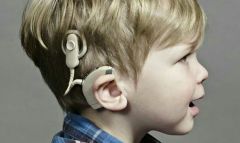
Cochlea implant |
Only way to help nerve deafness. Electronic device translates sound into electrical impulses, wired into cochlea's nerves, conveys some sound but nothing like real hearing. Controversial. |
|

Kinesthesis |
Sense of position and movement of body parts |
|
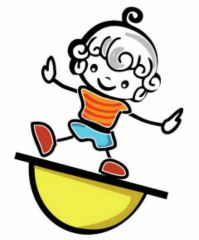
Vestibular sense |
Monitors head's position and movement- done by fluid in semicircular canals and vestibular sacs |
|
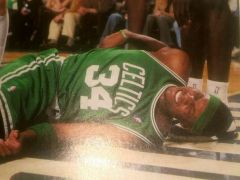
Gate control theory |
Spine has small nerve fibers for pain but larger ones for other other sensory signals. When injured, small fibers activate and pain gate is opened. Large fibre activity closes gate, blocking pain signals from reaching brain.
Hence why rubbing helps injury or basketball player can be distracted from pain until end of game. Then hurts. |
|
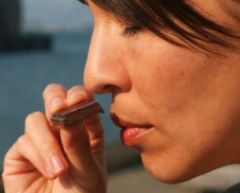
Sensory interaction |
Principle that one sense may influence another. Eg subtitles makes us hear what we read. Smell influences taste |
|
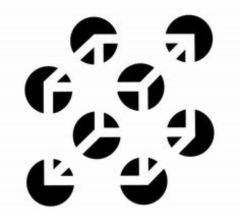
Gestalt |
A movement in psychology in Germany 1912 to determine why we organise things into meaningful perceptions |
|
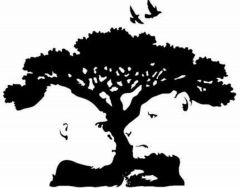
Figure ground |
Relationship between object and surroundings- eg white paper and inked words, music and surrounding noise etc. (In this picture the figure and ground can switch) |
|
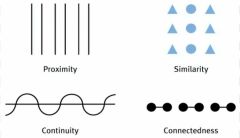
Grouping |
What the brain does to stimuli after basic sensations (eg colour, form) accounted for. Rules for grouping include proximity, similarity, continuity, connectedness |
|
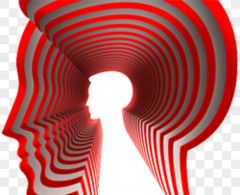
Depth perception |
Ability to percieve objects in 3 dimensions |
|
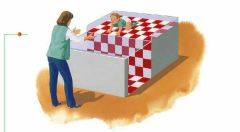
Visual cliff |
A minature cliff with a drop off covered by sturdy glass. |
|
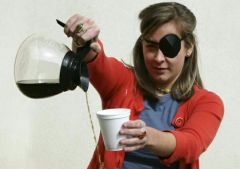
Binocular cues |
Visual information taken in by two eyes that enable us a sense of depth perception. Need to be seen by two eyes |
|

Retinal disparity |
Difference between inputs from each eye |
|
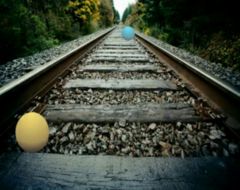
Monocular cues |
Depend on for sizes- when looking straight ahead retinal disparity not large is slight. Cues just as strong with one eye as with two eyes. |
|
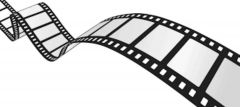
Phil phenomenon |
The optical illusion of perceiving a series of still images, when viewed in rapid succession, as continuous motion |
|
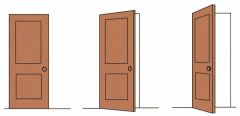
Perceptual constancy |
Ability to recognise objects without being decieved by change in colour, shape, size, brightness. Top down process |
|

Colour constancy |
When perceived color of objects remain relatively constant under varying illumination conditions eg red apple still seen as red in dark light, although technically not red anymore |
|
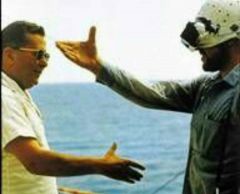
Perceptual adaption |
When visual input is changed to make world seem normal eg upside down or 40° distorted glasses. Adapt to it, then aftereffect once taken off |
|
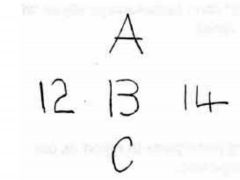
Perceptual set |
A mental predisposition given by experiences + assumptions that influences what we perceive. |
|
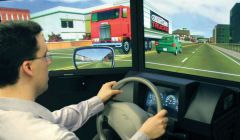
Human factor psychology |
A field where the behaviors and limitations of humans are used to design and evaluate products, tools, jobs and environments for the most effective use by humans |
|
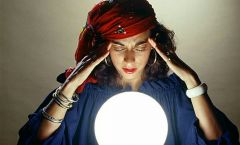
Extrasensory perception (ESP) |
Perceiving things by means other than the known senses, e.g., telepathy |
|
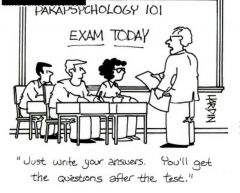
Parapsychology |
The study of inexplicable mental phemomena - extrasensory perception |

